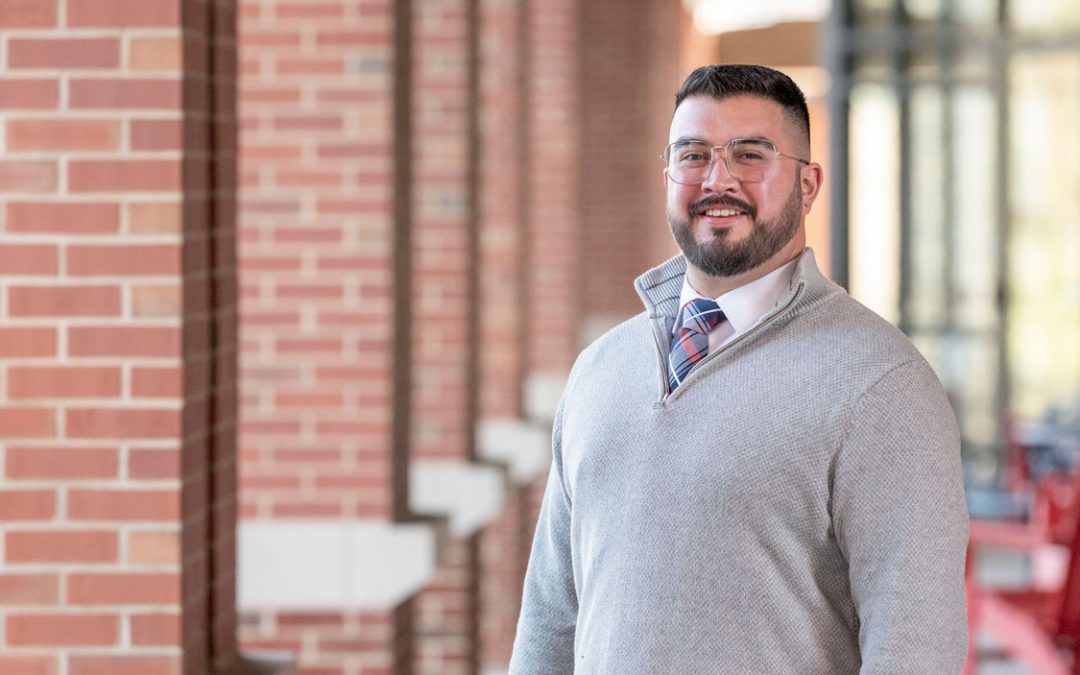
Molly Motes, a senior Japanese major, stands in the Arashiyama Bamboo Forest in Kyoto, Japan, during late December in 2020. Over the past decade, Motes and many others have found a community of likeminded and equally enthusiastic Japanese scholars in the Department of Language and Cultural Studies, which began offering a bachelor’s in the language in 2010. (Photo courtesy of Molly Motes)
Molly Motes had a penchant for international music as a preteen – German, French, anything she could
find online. When she was 11, she stumbled across a few Japanese pop songs.
Despite not understanding a word of it, she was captivated. With the click of a mouse, she opened a gateway to a new culture and a lifelong passion.
“It introduced me to the world of Japanese culture and language,” Motes says. “From there, I found things like
manga, anime, but the whole time I was thinking, ‘I really want to try learning this.’”
It’s a familiar story.
Many University of Missouri–St. Louis students become acquainted with Japan through cultural exports, and those
interests quickly evolve into a love of Japanese culture, history and language.
Over the past decade, many have found a community of likeminded and equally enthusiastic scholars in the
Department of Language and Cultural Studies, which began offering a bachelor’s in Japanese in 2010.
Since that time, the program has grown considerably, adding faculty members, offering study abroad programs and exchanges and fostering an active presence on campus through the Japan-America Student Association, or JASA. Many graduates have also gone on to participate in the prestigious and competitive Japan Exchange and Teaching Program.
Beth Eckelkamp, vice provost for student success and academic innovation, was instrumental in launching the program. Her parents were missionaries, who raised her on Japan’s northernmost island Hokkaido.
Eckelkamp’s bilingual background and an MA in Asian studies put her in an advantageous position to lead a new Japanese program at UMSL in 2000. By that time, Japan’s cultural impact on the U.S. was evident and interest in learning Japanese soared.
In its early days, the program offered lower-level undergraduate courses and a minor. By 2010, there was enough demand and institutional support to create a major. Amy Michael, associate teaching professor, was the first addition to the faculty, which continued to grow in the ensuing years.
Laura Miller, the Eiichi Shibusawa-Seigo Arai Endowed Professor of Japanese Studies and professor of history, helped the program take an important step forward by helping secure a Japan Foundation grant, tapping into her experience as a member of the advisory committee. That funded an additional faculty member – Associate Teaching Professor Keiko Ueda.
“It is truly significant that UMSL received one of these highly competitive grants,” Miller says. “It demonstrated that others believed in the potential of our Japanese language program.”
Ueda advanced the curriculum and paved the way for more progress.
“She really developed our reading classes, and she’s an amazing, amazing teacher,” Michael says. “Then, three years ago, we were able to add Hiroko Yoshii. Now that we have Hiroko on the team, we’ve been able to even better develop the final year of classes for the majors.”
High-quality instructors have been a boon to the Japanese language program’s success, but the soul of the program lies in cohort after cohort of dedicated students.
Like Motes, senior Danielle Bischoff’s path to learning Japanese began with pop culture. At a young age, Bischoff saw Hayao Miyazaki’s classic animated film, “Princess Mononoke,” which led to an interest in Pokémon. That soon turned into YouTube searches for subtitled Japanese anime. Spicy miso ramen, meanwhile, was the entry point for junior Michael Hendricks.
The three, like many of their classmates, also share an innate fascination with languages and the impulse to piece
together linguistic puzzles.
A middle school French class awakened Bischoff’s interest in languages, while Hendricks previously took stabs at
learning French, German, Russian and Spanish. Bischoff and Motes both tried to teach themselves Japanese.
“Nobody comes to it thinking it’s going to be easy,” Michael says. “Everyone knows Japanese is a challenging
language for English speakers to learn. They come in with a semi-realistic understanding of what they’re getting themselves into. I think the community is the first thing that helps them stick with it, being around other students who share that curiosity and who know they need to work hard to keep walking down this path.”
The experience quickly forges strong bonds and a group identity that Miller likens to an academic guild. Motes, now a senior and president of JASA, experienced the phenomenon in her very first class.
“I found that everyone else in class with me had that same level of passion,” she says. “We all immediately made a group chat, and we were messaging each other. We all had some previous interest in Japanese culture, language, music, anime – something that brought us all onto this common ground where we instantly became friends, and we stayed friends throughout the program.”
Hendricks adds that older students were always willing to provide guidance when he began the program. That
dynamic is reminiscent of the concept of senpai and kōhai.
“In Japanese culture, older people are supposed to take care of the young, and the young people eventually take care of the younger,” Yoshii explains. “A pay it forward system, so eventually everyone contributes to the society.”
Students enrich their understanding of Japanese culture and history through Miller’s courses, which cover everything from Japanese art history to religion; JASA cultural events such as calligraphy lessons and Rakugo storytelling; and most of all, study abroad opportunities.
In the past, students have taken part in semester-long or yearlong exchanges with institutions such as Kansai University, Rikkyo University and Toyo University. However, the most popular trip is the Japan Study Tour – a two-week summer session during which students visit businesses and cultural sites in Nagano, Nikko and Tokyo with faculty members.
“I try to help students maximize their opportunity to use Japanese,” Ueda says. “Sometimes, before we go to a restaurant together, I ask them to make an order for me. I might go to the restroom so when the server comes, they don’t try to talk to me.
“When they get to communicate with Japanese people, they seem so happy. I think seeing their excitement is the best part.”
Michael says students often come back with a clearer idea of how they intend to use their degrees in the future.
Several alumni have gone on to work for Japanese companies in the U.S. such as Mitsubishi Motors and Nidec Motor Company, where their language skills and cultural knowledge make them valuable intermediaries.
Others aspire to work in the billion-dollar video game industry or for Japanese media properties. Teaching English in Japan, through the JET program or otherwise, and translating are other popular options.
Bischoff is considering the JET program, and Hendricks is still weighing his options. Motes, who expects to graduate in December, is applying to master’s programs in Japan.
“I ended up falling in love with the idea of teaching English in Japan,” she says. “I’ve started working toward the goal of moving to Japan, ideally Tokyo, but anywhere, and teaching English as my career.”
This story was originally published in the fall 2021 issue of UMSL Magazine. If you have a story idea for UMSL Magazine, email magazine@umsl.edu.














